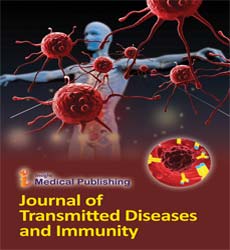Fungal Profile of Lower Respiratory Tract Infections and Drug Susceptibility Pattern among People Living with HIV in Addis Ababa, Ethiopia
Infectious Diseases and STD-AIDS
April 26-27, 2018 Rome, Italy
Ephrem T., Habteyes H., Zemedu M., Adane B.
Ethiopian Public Health Institute, Ethiopia Addis Ababa University, College of Health Sciences, Ethiopia
ScientificTracks Abstracts: J Transm Dis Immun
DOI: 10.21767/2573-0320-C1-002
Abstract
Background: Lower respiratory tract fungal infections are the most common cause of clinical manifestations among People Living with HIV (PLWHIV) and their impact is well documented. However, there is little information regarding the profile and drug susceptibility pattern of these pathogens. Thus, the aim of this study was to determine the profile of lower respiratory tract fungal pathogens and their drug susceptibility pattern among PLWHIV in Ethiopia. Methodology: A cross-sectional study was conducted in St Paul��?s hospital millennium medical college, Addis Ababa. We enrolled a total of 142 adult PLWHIV, with symptoms of lower respiratory tract infections consecutively. We used a structured questioner to collect socio-demographic variables and clinical data of the participants. One early morning sputum was collected for fungal culture and antimicrobial susceptibility testing. Four millilitre whole blood was also collected for CD4+ T cell count. Data was analyzed by IBM SPSS version 22.0. We used descriptive statistics to describe the profile and drug susceptibility pattern of fungal pathogens. We also used Pearson Chiesquare test to compare groups, and multiple logistic regression model was employed to determine factors associated with fungal infections. Results: Of total participants 62% were females and the average age was 39.8(+10.35) years with range 16 to 75 years. The overall fungal pathogens isolated were 32.4%, and Aspergillus species were the most frequently (11.3%) isolated pathogen. CD4+ T cell count (AOR = 1.02; 95% CI, (1.01 ��? 1.03)) and WHO HIV clinical stages (AOR = 6.1; 95% CI, (5.9 ��? 8.01)) were significantly associated with fungal infection. Candida species were susceptible to all antifungal agents; however Candida krusei was resistant to Fluconazole.�? Conclusion: The overall magnitudes of fungal pathogens isolated were considerable. Aspergillus species was the most frequently isolated fungal pathogen. CD4+ T cell count and WHO HIV clinical stages were significantly associated with fungal infection. Fungal pathogen screening among PLWHIV with symptoms of lower respiratory tract infections is crucial, while targeting individuals with low CD4+ T cell count and at advanced WHO HIV clinical stages. Keywords��? Lower Respiratory Tract Infections, fungi, Drug susceptibility pattern, Human Immunodeficiency Virus.�?
Biography
Ephrem have completed his BSc at the age of 21 years from Haramaya University and MSc from Addis Ababa University College of Health Sciences. He is the head of National TB Reference Laboratory and TB research team at the Ethiopian Public Health Institute. He has published more than 5 papers in reputed journals in collaboration with other researchers.
Email:ephremt13@gmail.com
Google Scholar citation report
Citations : 54
Journal of Transmitted Diseases and Immunity received 54 citations as per Google Scholar report
Abstracted/Indexed in
- Google Scholar
- China National Knowledge Infrastructure (CNKI)
- International Committee of Medical Journal Editors (ICMJE)
- Secret Search Engine Labs
Open Access Journals
- Aquaculture & Veterinary Science
- Chemistry & Chemical Sciences
- Clinical Sciences
- Engineering
- General Science
- Genetics & Molecular Biology
- Health Care & Nursing
- Immunology & Microbiology
- Materials Science
- Mathematics & Physics
- Medical Sciences
- Neurology & Psychiatry
- Oncology & Cancer Science
- Pharmaceutical Sciences

